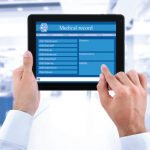 Recent proposals in the U.S. to bill for electronic communication with our patients could be seen as a refreshing but contested attempt to battle burnout rates in the present era. A fee for electronic communications between patients and clinicians also acknowledges the value of the clinician’s time and expertise. But is this ethical?
Recent proposals in the U.S. to bill for electronic communication with our patients could be seen as a refreshing but contested attempt to battle burnout rates in the present era. A fee for electronic communications between patients and clinicians also acknowledges the value of the clinician’s time and expertise. But is this ethical?
Discussion
Burnout rates in medicine continue to skyrocket, and many clinicians are leaving our field.1,2 Numerous experts have postulated causes for these rates of exhaustion, citing long hours, insurance company battles and the ever-encroaching electronic medical record. We don’t aim to solve these problems in our article, but we do acknowledge that the clinician’s electronic inbox does not promote job satisfaction, particularly given the growth in patient use since the beginning of the pandemic.3
In the present milieu, which undoubtedly will be considered an era of technological revolution, we have all, for better or worse, become much more reachable. Telephones have turned into cell phones. Cell phones have turned into computers. From our pockets, these devices continuously call out their siren songs for our attention. Emails, texts, tweets, Facebook—we can all be reached in innumerable ways.
For patients, electronic communication increases access to the healthcare system and can improve their care. This is particularly true for patients facing transportation challenges or burdensome work hours that can limit their ability to attend in-person appointments. Further, in recent years, shortages of clinicians in some specialties have resulted in several months’ wait times for clinic visits. Electronic messaging between patient and clinician can shorten these delays in care.
Adding fees to electronic messaging risks nullifying these advantages for patients with limited means.
A likely point of agreement: Not every inbox message’s urgency is equal. We all appreciate the modern ease with which patients can relay urgent matters to their healthcare clinicians, but given the simplicity of contacting one’s clinician with the stroke of one’s fingers, the reality is that the modern medical inbox is diluted with less critical and more irrelevant requests.
Triage
Ralph Waldo Emerson noted that Napoleon Bonaparte “directed [his diplomat] to leave all letters unopened for three weeks, and then observed with satisfaction how large a part of the correspondence had thus disposed of itself, and no longer required an answer.”4 While one would not advocate ignoring patients for three weeks at a time, we can appreciate the underlying parallel to our own communications.
Triage dictates how we allocate care, from battlefields and emergencies to the substantially less dramatic environment of the inbox. Its practice is guided by the principle of justice. Traditionally, distributive justice in medical ethics refers to allocation of material resources, from organs to imaging to medications.5 Amid our shrinking workforce, clinician work hours should be considered an equally limited resource.
Given this, should we abide by the unwritten mandate to respond to non-urgent patient electronic communication requests without a fee? Might this unequally divert care to the more vocal, but possibly less sick, patient and away from the possibly sicker, although technologically less inclined? This clearly is antithetical to triage. Despite attempts to maximize beneficence in dutifully managing our inbox requests, squandering time on one task inevitably takes away from another. Consideration of these other tasks is critical.
Billing Considerations
Clearly, when formulating billing guidelines, care must be taken to prevent another scenario: Deterring urgent and critical communication from our patients. The guidelines should also avoid impeding the tasks that patient portals streamline, such as scheduling appointments and requesting appropriate and routine medication refills. By following a triage-based approach, the needs of the patient, the time of the clinician and health equity concerns could be balanced.
Perhaps, as some models have already espoused, emails about simple matters, such as prescription refills, simple follow-up care questions and scheduling of appointments could be free of charge.
Alternatively, messages regarding new medical issues, changes in symptoms for chronic conditions and consideration of medication changes could include a charge to recognize the additional time and effort required of the clinician.
To minimize the potential for worsening healthcare inequity, a charge structure for these services should account for the patient’s ability to pay. For example, those on Medicaid or charity care may be exempt from co-pays. Clinicians themselves could waive fees altogether on a case-by-case basis. (In itself, returning some autonomy to the clinician seems a natural way to improve work satisfaction.)
The concerns that fees would deter healthcare access for critical matters and adversely affect healthcare equity are major arguments against charging for patient messages.
We must pause before we assume patient electronic messages are the remedy for all sources of healthcare access inequity. Okobi et al. noted discrepancies in electronic medical record use among populations of rural vs. urban areas, with lower rates of internet access and use of digital health technology for communicating with the healthcare system among rural populations.6
Clearly, we must not overemphasize the idea that electronic systems alone may bridge the gap in healthcare inequality; they may actually exacerbate certain distribution imbalances.
In Sum
Electronic communications can help patients better access our healthcare system and improve healthcare equity. However, unchecked, this same system can overwhelm us and hamper our ability to care not only for our patients, but for ourselves.
To advance patient and clinician well-being, the healthcare system should recognize electronic communications as essential aspects of clinician productivity. Although billing for these services may be a good first step, further codification of the appropriate use of the inbox will be needed to balance both patient and clinician priorities. Electronic healthcare reform itself will need to be bundled with other initiatives to allow clinicians to thrive and optimize patient care.
 James Topilow, MD, is a second-year rheumatology fellow at Johns Hopkins School of Medicine, Baltimore. Following his fellowship, he will join Hackensack Meridian School of Medicine, New Jersey.
James Topilow, MD, is a second-year rheumatology fellow at Johns Hopkins School of Medicine, Baltimore. Following his fellowship, he will join Hackensack Meridian School of Medicine, New Jersey.

Yvonne M. Golightly, PT, MS, PhD, is a professor and assistant dean for research at the University of Nebraska Medical Center College of Allied Health Professions, Omaha. She is a musculoskeletal epidemiologist and a physical therapist with 20 years of experience in research and over a decade of clinical practice.
References
- Tiwari V, Kavanaugh A, Martin G, et al. High burdens of burnout on rheumatology practitioners. J Rheumatol. 2020 Dec 1;47(12):1831–1834.
- Rittenberg E, Liebman JB, Rexrode KM. Primary care physician gender and electronic health record workload. J Gen Intern Med. 2022 Oct;37(13):3295–3301.
- Holmgren AJ, Downing NL, Tang M, et al. Assessing the impact of the COVID-19 pandemic on clinician ambulatory electronic health record use. J Am Med Inform Assoc. 2021 Jan 29;29(33):453–460.
- Emerson RW. Representative Men: Seven Lectures. SoHo Square: George Routledge & Co.; 1850.
- Varkey B. Principles of clinical ethics and their application to practice. Med Princ Pract. 2021;30(1):17–28.
- Okobi E, Adigun AO, Ozobokeme O, et al. Examining disparities in ownership and use of digital health technology between rural and urban adults in the US: An analysis of the 2019 health information national trends survey. Cureus. 2023 May 2;15(5):e38417.
Editor’s note: Got a question or comment? Email us at [email protected].


